Availability
![]() Distribution
Distribution
![]() News
News
![]() Notes
Notes
![]() Overview
Overview
![]() Pricing
Pricing
![]() Products
Products
Accessories and Options
![]() Mounts
Mounts
![]() Mount Control Systems
Mount Control Systems
![]() Telescopes
Telescopes

BAADER Planetarium/Carl Zeiss Binocular Viewer
Discontinued and replaced in 2003 by the improved Baader Mark V model
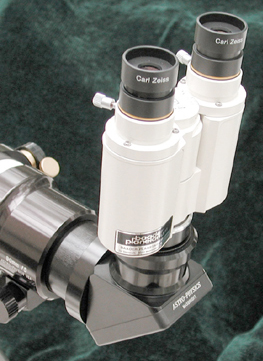 Left: Binocular Viewer with two optional Zeiss oculars in place, attached to Astro-Physics 90mm "Stowaway" Telescope 2" Focuser, with optional Maxbright Diagonal (114,009 bytes). This image shows the tacky stick-on Baader label on lower left barrel; this label can be easily removed, and the residue adhesive cleaned off with a mild solvent.
Left: Binocular Viewer with two optional Zeiss oculars in place, attached to Astro-Physics 90mm "Stowaway" Telescope 2" Focuser, with optional Maxbright Diagonal (114,009 bytes). This image shows the tacky stick-on Baader label on lower left barrel; this label can be easily removed, and the residue adhesive cleaned off with a mild solvent.
Overview: The Baader/Carl Zeiss binocular viewer is an accessory that provides a more comfortable view for an observer by permitting experienced or inexperienced observers the comfort of viewing simultaneously with both eyes. This binocular viewer was one of the few which were engineered for astronomy, most other being converted from microscopes and not all that pleasing. This system was engineered and first manufactured entirely in house by the most capable optics house in the world: Carl Zeiss of Germany.
The images by this binocular viewer can be breath taking, producing a view that is unrivaled by other similar binocular viewers in terms of contrast, clarity, and uniform distribution of light. The most mesmerizing aspect of this device is how the objects observed may appear quite "three dimensional". The binocular viewer is particularly desirable for observing the planets, moon, and sun (when the telescope is equipped with a suitable filter), and depending on the qualities of the telescope for observing some of the brighter "deep sky" objects.
History: Engineered in the late 1980's Carl Zeiss Jena V.E.B. (formerly in East Germany) manufactured an excellent Binocular Viewer which was sold bearing the trademark "Zeiss". This accessory was developed specifically for use on astronomical telescopes unlike most others up to that time which were usually adapted for use on telescopes from from microscopes; these often incorporated prisms designed for use with smaller .965 inch eyepieces and often vignetted when used with astronomical telescope 1.25 inch oculars. When the Carl Zeiss Jena amateur telescope division was closed in the Fall of 1995, their telescopes and most accessories including the binocular viewer went out of production.
This binocular viewer was at the time considered by us and many in the amateur astronomy community to be unrivaled in performance, so much so that when it was sold under the Zeiss trademark at $1,000 or so, after being discontinued the prices for these scarce commodities on the used market went rapidly to $2,000 and more at times.
In 1996, the German firm "Baader Planetarium" company acquired the rights to buy the optics from the reformulated Carl Zeiss, the patterns and mechanical drawings to manufacture the Zeiss Binocular Viewer. By 1998 word was out that we would again be able to offer the same binocular viewer but with the Baader Planetarium trademark. The optics, body and mechanical works are produced and assembled by Baader Planetarium according to the original specifications by Carl Zeiss.
The new production model is a duplicate of the original much sought after Carl Zeiss Jena unit but now bearing the trade mark "Baader Planetarium". It is distributed in the U.S.A. only by Astro-Physics and Company Seven. We are very pleased to offer this fine Binocular Viewer once again. However, production is limited and so those who desire such a unit should contact us to get onto our ordering list, and to discuss compatibility, interpupilary distance, and eyepiece selection issues.
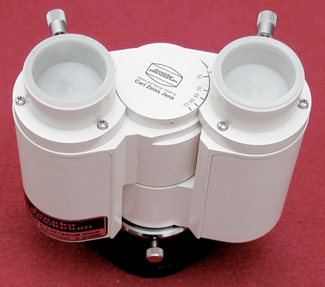 Right: Baader Binocular Viewer. Weight 1 lb. 14 oz. (without diagonal). (75,809 bytes).
Right: Baader Binocular Viewer. Weight 1 lb. 14 oz. (without diagonal). (75,809 bytes).
Operation: The binocular viewer is slip fit accessory. We suggest it be installed into a 2 inch diameter (or larger) focuser although it comes equipped for use on 1.25" focusers. The best results will be obtained when using the binocular viewer with refracting telescopes of good to excellent quality. When using smaller telescopes (4 inch refractors for example) on an Alt Azimuth mount, then you find it desirable if not necessary to acquire a strap-on weight (possibly an exercise ankle weight for example) to help in balancing the load of the binocular viewer on the telescope.
This binocular viewer incorporates several features unprecedented in our industry engineered to provide optimum performance and years of use; this remains the standard of excellence against which we measure alternatives.
The highly perfected optical components which include beam splitter, lens and prism systems are designed and manufactured by Carl Zeiss, Germany. The optical components feature the world renowned "Zeiss T*" antireflection coatings. These are combined with the original Zeiss designed castings, and mechanical components (which are now made by a third party) to assure high transmission of the incoming light from a telescope, and a very even split of the light into two parallel images.
The binocular viewer incorporates a beam splitter which naturally introduces some spherical aberration and a slight color error therefore, a 1.25X compensating element is built in (which can be removed if so desired) to eliminate the slight errors that would otherwise be barely perceptible. The optical system affords full, and uniform illumination of 1.25 inch diameter eyepieces. This element (also known as a "Glaspath Compensator") was designed by Roland Christen and is essential for use on telescopes with fast focal ratios. This Binocular Viewer is the only one on the market with this interchangeable feature. We also offer the 1.7x (BP4B) and 2.6x (BP4C) Glaspath Compensators.
The light from a telescope passing through the binocular viewer is precisely fed into the user's choice of two 1.25 inch diameter eyepieces. These eyepieces should be of high quality, and must have a similar or exactly matched focal length. Company Seven has tested eyepieces over the years and find the stated focal length of even a reliable manufacturer can vary by +-5 percent or so. And so if one of our binocular viewer customers orders eyepieces for use with the viewer, then Company Seven will have the eyepieces evaluated as a pair to insure similar magnification between the two.
The furnished removable multi coated high quality 1.25" diameter 90 degree angled prism diagonal facilitates the observing of objects overhead, while the "Bayonet Straight Through Viewing Adapter" which accepts the furnished thread-in 2 inch male Barrel (threaded for 48mm filters) are also included for those who prefer to observe "straight through", or whom lack the back focus to accommodate the Prism. If you prefer to use the furnished 1.25" prism on a telescope with a 2" focuser, then we suggest that you employ our Astro-Physics 2" to 1.25" reducer (ADA125); this is a non marring fitting, with a locking clamp as is furnished with the Maxbright diagonal and most other Astro-Physics fittings and all their telescopes. The 2" to 1.25" reducer has a low profile, taking up only 1/4 inch of back focus, and it too is threaded on the 2" barrel to accept most 48mm filters.
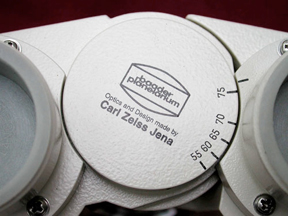 Left: Baader Binocular Viewer interpupilary spacing scale (45,195 bytes). The interpupilary distance (spacing between the observers eyes) is easily adjusted to accommodate most people. The prism and eyepiece holder castings are hinged and so the adjustment may be made by simply pivoting the barrels in or out.
Left: Baader Binocular Viewer interpupilary spacing scale (45,195 bytes). The interpupilary distance (spacing between the observers eyes) is easily adjusted to accommodate most people. The prism and eyepiece holder castings are hinged and so the adjustment may be made by simply pivoting the barrels in or out.
Backfocus: The backfocus requirements will vary depending upon your configuration. Some telescopes (including some earlier production Astro-Physics telescopes, and Newtonians in particular) may not provide the 5 inch or so back focus necessary to permit the stand alone use of the Binocular Viewer. You should study the table below for more information about this.
It is a simple matter to measure how much Back Focus to the Focal Plane your telescope provides. Simply point the telescope to a bright object (such as the Moon). Then remove the eyepiece and diagonal. Now gradually move a sheet of wax paper in or out at the rear of the telescope until the image of the moon comes to sharpest focus. Then measure the spacing from the telescope focuser draw tube to the "Focal Plane". If you have less than 5 or 6 inches then you will probably have to use a Barlow lens ahead of the binocular viewer to project the image and attain focus.
To increase magnification provided by a telescope for use in observing relatively small and bright objects, or to achieve focus with telescopes of limited back focus, or simply to economize on eyepiece selection we suggest the use of the optional modular Astro-Physics 2 inch diameter Barlow lens. This Barlow Lens is a modular component designed so that it can be used installed between the binocular viewer and a telescope in any of a number of configurations. The Astro-Physics Barlow lens may be put in place either with its furnished extension tube (providing about 2X), or with the Barlow lens removed from the extension and then threaded directly onto the furnished Baader Prism Diagonal (providing 2.4X), or threaded onto the Astro-Physics "Maxbright" diagonal (about 2.6X), or close coupled onto the Binocular Viewer 2" Male Fitting.
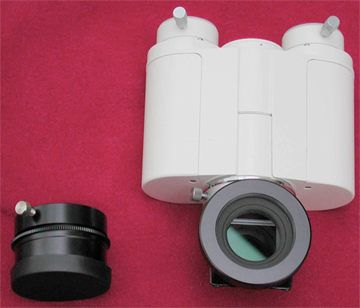 Right: Baader Binocular Viewer with furnished 2" Nose piece at left, and with 1.25" Prism attached to the binocular viewer (73,001 bytes).
Right: Baader Binocular Viewer with furnished 2" Nose piece at left, and with 1.25" Prism attached to the binocular viewer (73,001 bytes).
Filters: Since Binocular Viewers are so often used on relatively bright objects (planets, moon, etc.) as well as on deep sky objects the Baader Binocular Viewer have been provided with a 2 inch nosepiece which is threaded to accept 48mm filters. Company Seven provides optional very high quality filters:
- color
- Neutral Density
- Sky Light Pollution Reduction
Retrofit Earlier Units: The original Carl Zeiss and early production Baader Binocular viewers made through 23 February 2000 incorporate a casting that was designed to accommodate eyepieces with barrel lengths of up to 1.2 inch (30.5mm). Eyepieces with barrels longer than this (such as the TeleVue "Radian" series and TeleVue 22mm Panoptic) can be accommodated in those Baader Binocular Viewers made since July 2000 since these incorporate a stop to prevent damage to the internal prism.
In keeping with out policy of eternal support, a retrofit "Eyepiece Stop Ring" kit is available from us for units delivered prior to the design change. With this stop in place, some long barreled eyepiece sets may require you draw the right ocular out a bit before locking it in place; if this is a bother then we do also offer optional Parfocal Rings. Please contact us for more information about these accessories.
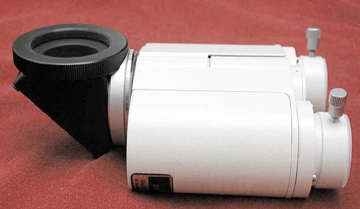
Above: Baader Binocular Viewer with provided Baader 1.25" Prism Diagonal attached (62,420 bytes).
Backfocus in-travel is the distance difference between where the light focuses (Focal Plane) and the back of the focuser body.
- Binoviewer with 1.25x Compensator, 2" Barrel and Convertible Barlow - needs 0.6" in-travel
- Binoviewer with 1.25x Compensator, Prism and Convertible Barlow - needs 1.8" in-travel
- Binoviewer with 1.25x Compensator and 2" Adapter - needs 3.5" in-travel
- Binoviewer with 1.25x Compensator and Prism - needs 4.5" in-travel
- Binoviewer with 1.75x Compensator, 2" Barrel and Convertible Barlow - needs 0.7" out-travel
- Binoviewer with 1.75x Compensator, Prism and Convertible Barlow - needs 0.55 " in-travel
- Binoviewer with 1.75x Compensator and 2" Adapter - needs 2.25" in-travel
- Binoviewer with 1.75x Compensator and Prism - needs 3.25" in-travel
If you do not use the 1.25x compensator, the backfocus is increased by 1.25x in all configurations
- Binoviewer with 2" Barrel and Convertible Barlow - needs 0.9" in-travel
- Binoviewer with Prism and Convertible Barlow - needs 2.25" in-travel
- Binoviewer with 2" Adapter - needs 4.4" in-travel
- Binoviewer with Prism - needs 5.6" in-travel.
COMPONENTS INCLUDED:
- Binocular Viewer with 1.25x Glaspath Compensator installed on the main housing
(easily removed, 1.25" Compensator Lens is sold separately as part # BP4A) - 2" Barrel (2"/T-2 Nosepiece Extension, sold separately as part # BP16 or AP16)
- Prism (T-2 Stardiagonal Prism, sold separately as part # BP1)
- Bayonet (T-2 Quick Changer, sold separately as part # BP6)
Above: Baader Binocular Viewer and Typical Accessories Diagram (168,213 bytes).
CLEANING & MAINTENANCE INSTRUCTIONS:
- It is best to protect this accessory from shock, vibration, dust and dirt. When not in use, store it in a well padded container or carrying case, and keep the lens covers in place. Do not pack the accessory into airtight containers when wet (from dew, etc.) for long periods of time; whenever possible let the accessory "dry out" and store it with desiccant in order to reduce the potential for problems associated with Fungus, etc.
- Do not ever disassemble the Binocular Viewer housing to clean it, or the optics inside.
- Draw any large, loose bits of foreign matter from the surface of the prisms with an air bulb or small vacuum. Stubborn particles can be removed with a soft camel's hair brush.
- Place a few drops of an approved lens cleaning solution (by Kodak, etc.) or mild soap solution of clear dish washing liquid diluted with distilled water onto a cotton swab. Then gently wipe in a circular motion with little or no pressure. Although these optics incorporate durable multi-coatings coatings, they can be damaged by hard rubbing if there are tiny abrasive dirt particles on the glass.
- Follow immediately with a denatured alcohol wetted tissue (removes fingerprints ) and a final swipe with an acetone wetted tissue (removes stains). The acetone also leaves the surface in an antistatic state which will help to prevent dust attraction. Keep the acetone away from the antireflection black paint.
Contents Copyright 1994-2002 Company Seven, with Photos Courtesy of Paul Gustafson - All Rights Reserved

